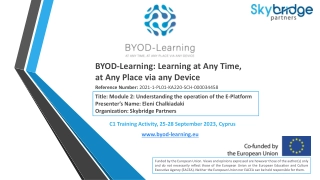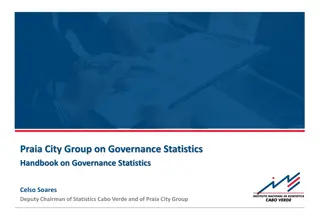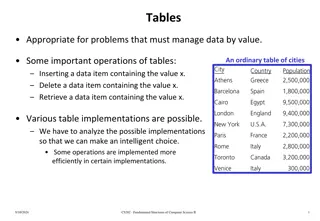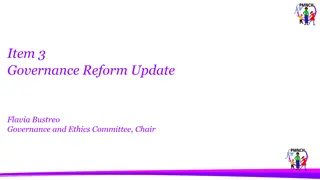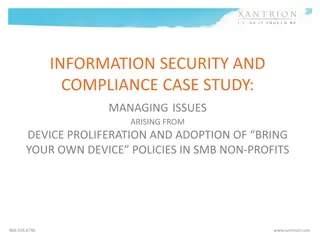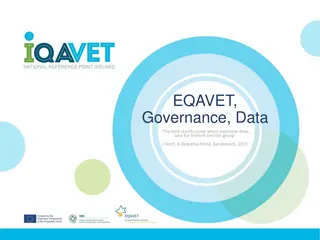BYOD Implementations and Information Governance Overview
Relatively new phenomena surrounding Bring Your Own Device (BYOD) policies in workplaces are discussed, along with the adoption rates, implementation scenarios, and the importance of Information Governance. The presentation delves into the challenges and benefits of BYOD, including security, productivity, and accessibility, while emphasizing the need for clear policies and compliance measures. Information Governance is defined as a framework to regulate the use of information effectively within organizations.
Uploaded on Oct 09, 2024 | 0 Views
Download Presentation

Please find below an Image/Link to download the presentation.
The content on the website is provided AS IS for your information and personal use only. It may not be sold, licensed, or shared on other websites without obtaining consent from the author. Download presentation by click this link. If you encounter any issues during the download, it is possible that the publisher has removed the file from their server.
E N D
Presentation Transcript
BRING YOUR OWN DEVICE Presenter: Rachelle R. Green Duffy & Sweeney, Ltd.
OVERVIEW Relatively new phenomena Cell phones have been in workplaces for years, but huge increase in use of smart phones and tablets raise new issues re: safety, security, privacy, and wage and hour compliance Issues and resolutions vary by company
A New Style of IT Data, Data Everywhere Mobile, Social, Big Data & the Cloud Mainframe Client/Server Internet Every 60 seconds: 698,445 Google searches 695,000 status updates 217 new mobile web users 168 million+ emails sent 98,000+ tweets 11 million instant messages 1,820 TB of data created
BYOD Adoption 75% of surveyed organizations allow employee BYOD! Consumerization of IT Increased Productivity Appeal of consumer technology Convenience for users Increased accessibility Reduced expenses Recruiting tool What s Driving BYOD Adoption? 51% could bring any device, with little to no policy measures Only 24% had any sort of compliance policy in place
BYOD Implementation Scenarios Embrace Allow everyone to use all devices to access all resources High Embrace Contain Contain Allow some people to use some devices to access some resources Business Value Disregard Ignoring the presence of personally owned devices in a corporate environment Disregard Block Low Block Ban the use of consumer- grade products or services by explicitly prohibiting their use in an appropriate policy Low High Security Pressure Gartner, NAC Strategies for Supporting BYOD Environments, December 2011, Lawrence Orans and John Pescatore
What is Information Governance? Gartner defines information governance as the specification of decision rights and an accountability framework to encourage desirable behavior in the valuation, creation, storage, use, archival and deletion of information. It includes the processes, roles, standards and metrics that ensure the effective and efficient use of information in enabling an organization to achieve its goals http://www.gartner.com/it-glossary/information-governance
Increased Productivity & Accessibility Cool factor/morale Convenience/work-life Physical & Cyber Security Confidentiality Privacy v. monitoring Data flows/access Mobile Device Management NAC Employment Issues Wage/Hour Expense Reimbursement Harassment Global Trade/encryption IT Infrastructure Hardware savings Bandwidth/Network App selection/development Records & Info Management Legal Hold/Discovery http://www.edrm.net/archives/13649
The Implementation Roadmap BYOD Policy fundamentals Components of a BYOD program Privacy Issue Spotting Security Issue Spotting The Scope of BYOD Defining BYOD
Security Issue Spotting Managing Devices Enforcement Trainings Policies
Privacy Issue Spotting International Workforce Access to Data Litigation Hold and E- Discovery Retention
Other Best Practices Understand your mobile device population Hypo Make Enrollment Easy Configure Devices Over-the-Air Provide Self-Service Designate Personal Information as Secure Isolate Corporate from Personal Data Continuously Monitor Manage Data Usage Consider how Policy Impact ROI
Additional Concerns EEO and Harassment Records Management and Data Collection International Challenges Wage & Hour Risks Safety Concerns


